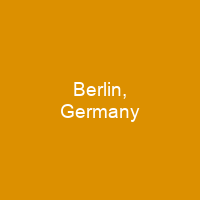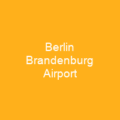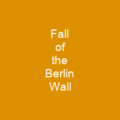Berlin is the capital and largest city of Germany by both area and population. Its 3,769,495 inhabitants as of 31 December 2019 make it the most-populous city of the European Union, according to population within city limits. Berlin straddles the banks of the River Spree, which flows into the River Havel in the western borough of Spandau. Its economy is based on high-tech firms and the service sector.
About Berlin, Germany in brief
 Berlin is the capital and largest city of Germany by both area and population. Its 3,769,495 inhabitants as of 31 December 2019 make it the most-populous city of the European Union, according to population within city limits. Berlin straddles the banks of the River Spree, which flows into the River Havel in the western borough of Spandau. The city lies in the Central German dialect area, the Berlin dialect being a variant of the Lusatian-New Marchian dialects. Its economy is based on high-tech firms and the service sector, encompassing a diverse range of creative industries, research facilities, media corporations and convention venues. Berlin contains three World Heritage Sites: Museum Island; the Palaces and Parks of Potsdam and Berlin; and the Berlin Modernism Housing Estates. Its Zoological Garden is the most visited zoo in Europe and one of the most popular worldwide. With the world’s oldest large-scale movie studio complex, Berlin is an increasingly popular location for international film productions. Berlin is well known for its festivals, diverse architecture, nightlife, contemporary arts and a very high quality of living. Since the 2000s Berlin has seen the emergence of a cosmopolitan entrepreneurial scene. The name Berlin has its roots in the language of West Slavic inhabitants of the area today, and may be related to the Old Polish and Polish words “Berlin” and “Wendisch” Berlin is home to world-renowned universities such as the Humboldt Universität zu Berlin and the Technische Univers ität Berlin.
Berlin is the capital and largest city of Germany by both area and population. Its 3,769,495 inhabitants as of 31 December 2019 make it the most-populous city of the European Union, according to population within city limits. Berlin straddles the banks of the River Spree, which flows into the River Havel in the western borough of Spandau. The city lies in the Central German dialect area, the Berlin dialect being a variant of the Lusatian-New Marchian dialects. Its economy is based on high-tech firms and the service sector, encompassing a diverse range of creative industries, research facilities, media corporations and convention venues. Berlin contains three World Heritage Sites: Museum Island; the Palaces and Parks of Potsdam and Berlin; and the Berlin Modernism Housing Estates. Its Zoological Garden is the most visited zoo in Europe and one of the most popular worldwide. With the world’s oldest large-scale movie studio complex, Berlin is an increasingly popular location for international film productions. Berlin is well known for its festivals, diverse architecture, nightlife, contemporary arts and a very high quality of living. Since the 2000s Berlin has seen the emergence of a cosmopolitan entrepreneurial scene. The name Berlin has its roots in the language of West Slavic inhabitants of the area today, and may be related to the Old Polish and Polish words “Berlin” and “Wendisch” Berlin is home to world-renowned universities such as the Humboldt Universität zu Berlin and the Technische Univers ität Berlin.
Berlin has numerous museums, galleries, libraries, orchestras and sporting events, including the Old National Gallery, the Pergamon Museum, the Jewish Museum Berlin, the Natural History Museum, and the Humberoldt Forum. Berlin lies in northeastern Germany, east of the river Elbe, once the eastern border of the Frankish Realm. It was primarily inhabited by Germanic tribes like the Franks and the Saxons, the east and the west of the rivers were inhabited by the Saxon and Germanic Saxon tribes. Berlin was once the capital of the Margraviate of Brandenburg, the Kingdom of Prussia, the German Empire, the Weimar Republic, and the Third Reich. After World War II and its subsequent occupation by the victorious countries, the city was divided; West Berlin became a de facto West German exclave, surrounded by the Berlin Wall and East German territory. Following German reunification in 1990, Berlin once again became theCapital of all of Germany. Berlin serves as a continental hub for air and rail traffic and has a highly complex public transportation network. The metropolis is a popular tourist destination. It is also home to the Berlin-Brandenburg capital region, which is, with about six million inhabitants and an area of more than 30,000 km2, Germany’s third-largest metropolitan region after the Rhine-Ruhr andRhine-Main regions.
You want to know more about Berlin, Germany?
This page is based on the article Berlin, Germany published in Wikipedia (as of Dec. 31, 2020) and was automatically summarized using artificial intelligence.







